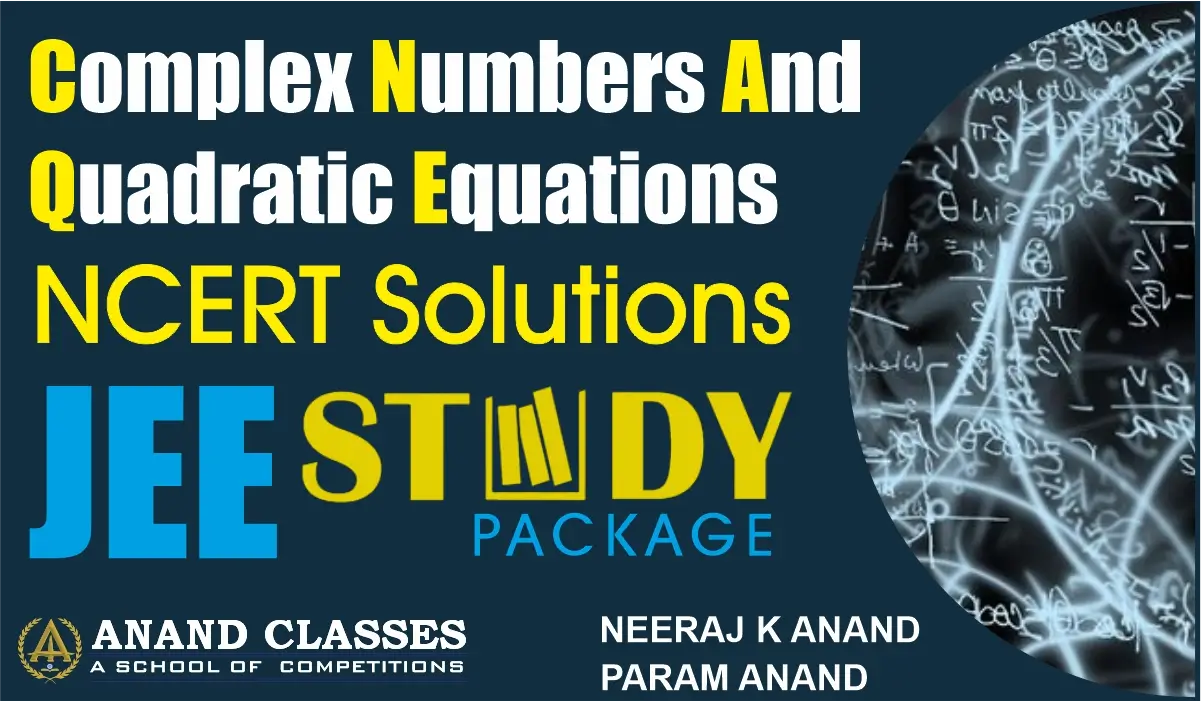Anand Classes offers comprehensive NCERT Solutions for the Miscellaneous Exercise of Complex Numbers & Quadratic Equations (Class 11 Maths), with step-by-step derivations, solved examples, and full explanations. This set includes all types of problems—expressing complex numbers in a + ib form, operations on complex numbers, roots of quadratic equations, nature of roots, discriminants, and relations between roots—in a coherent and student-friendly manner. All solutions align with the NCERT curriculum and are ideal for exam preparation and revision. Students can download the solutions in free PDF format to access the content offline. Click the print button to download study material and notes.
Q.1 : Evaluate: $$([i^{18} + \frac{1}{i^{25}}]^3)$$
Solution : Given
$$
([i^{18} + \frac{1}{i^{25}}]^3)
$$
Rewrite powers as multiples of 4:
$$
i^{18} = i^{4 \cdot 4 + 2} = (i^4)^4 \cdot i^2
$$
$$
(1/i)^{25} = 1/i^{25} = 1/(i^{4\cdot6 + 1}) = 1/((i^4)^6 \cdot i)
$$
Since ($i^4 = 1$) and ($i^2 = -1$):
$$
[i^{18} + (1/i)^{25}]^3 = [-1 + 1/i]^3
$$
Rationalize (1/i):
$$
\frac{1}{i} \cdot \frac{i}{i} = \frac{i}{i^2} = -i
$$
Hence:
$$
[-1 + 1/i]^3 = (-1 – i)^3
$$
Expand the cube:
$$
(-1 – i)^3 = (-1)^3 + 3(-1)^2(-i) + 3(-1)(-i)^2 + (-i)^3
$$
Compute powers of (i) (($i^2=-1, i^3=-i$)):
$$
(-1 – i)^3 = -1 – 3i + 3 + i = 2 – 2i
$$
Answer:
$$(\boxed{2 – 2i})$$
Q.2 : Prove that $$Re(z_1 \;z_2) = Re z_1 \;Re z_2 – Im z_1\; Im z_2$$
Solution : Let
$$
z_1 = x_1 + i y_1, \quad z_2 = x_2 + i y_2
$$
Multiply:
$$
z_1 z_2 = (x_1 + i y_1)(x_2 + i y_2)
$$
Step by step:
$$
z_1 z_2 = x_1 x_2 + i x_1 y_2 + i x_2 y_1 + i^2 y_1 y_2
$$
Since ($i^2=-1$):
$$
z_1 z_2 = (x_1 x_2 – y_1 y_2) + i(x_1 y_2 + x_2 y_1)
$$
Hence:
$$
Re(z_1 z_2) = x_1 x_2 – y_1 y_2
$$
Also:
$$
Re z_1 \;Re z_2 – Im z_1\; Im z_2 = x_1 x_2 – y_1 y_2
$$
Hence proved.
$$
Re(z_1 z_2) = Re z_1 \;Re z_2 – Im z_1\; Im z_2
$$
Note : Similar property :
$$
Im(z_1 z_2) = (x_1 y_2 + x_2 y_1)
$$
$$
Re z_1 \;Im z_2 + Re z_2\; Im z_1 = (x_1 y_2 + x_2 y_1)
$$
$$
Im(z_1 z_2) = Re z_1 \;Im z_2 + Re z_2\; Im z_1
$$
Q.3 : Reduce to standard form:
$$
\left(\frac{1}{1 – 4i} – \frac{2}{i + 1}\right) \frac{3 – 4i}{5 + i}
$$
Solution
Step 1: Compute the bracket:
$$
\frac{1}{1 – 4i} – \frac{2}{i + 1} = \frac{-1 + 9i}{5 – 3i}
$$
Step 2: Multiply by $(\frac{3 – 4i}{5 + i})$
$$
\frac{-1 + 9i}{5 – 3i} \cdot \frac{3 – 4i}{5 + i}
$$
Step 3: Split numerator and denominator:
Numerator:
$(-1 + 9i)(3 – 4i)=$
$= (-1 \cdot 3) + (-1 \cdot -4i) + (9i \cdot 3) + (9i \cdot -4i) $
$= 33 + 31i$
Denominator:
$
(5 – 3i)(5 + i) = $
$=(5 \cdot 5) + (5 \cdot i) + (-3i \cdot 5) + (-3i \cdot i) $
$= 28 – 10i$
Step 4: Rationalize:
$$
\frac{33 + 31i}{28 – 10i} \cdot \frac{28 + 10i}{28 + 10i} = \frac{614 + 1198i}{884}
$$
Step 5: Simplify:
$$
\frac{614 + 1198i}{884} = \frac{307}{442} + i \frac{599}{442}
$$
Answer:
$$
\boxed{\frac{307}{442} + i \frac{599}{442}}
$$
Q.4 : If
$$
x – i y = \sqrt{\frac{{a – i b}}{c – i d}}
$$
prove that
$$
(x^2 + y^2)^2 = \frac{a^2 + b^2}{c^2 + d^2}.
$$
Solution
Let $u=a-i b$ and $v=c-i d$. Then
$$
x – i y = \sqrt{\frac{{u}}{v}}
$$
$$
x – i y = \frac{\sqrt{u}}{\sqrt{v}}.
$$
Take modulus of both sides. Using $|\sqrt{Z}|=\sqrt{|Z|}$ and $|Z_1/Z_2|=|Z_1|/|Z_2|$ we get
$$
|x – i y| = \frac{|\sqrt{u}|}{|\sqrt{v}|} = \frac{\sqrt{|u|}}{\sqrt{|v|}}
= \sqrt{\frac{|u|}{|v|}}.
$$
Square both sides:
$$
|x – i y|^2 = \frac{|u|}{|v|}.
$$
But $|x – i y|^2 = x^2 + y^2$, and
$$
|u| = |a – i b| = \sqrt{a^2 + b^2},\qquad
|v| = |c – i d| = \sqrt{c^2 + d^2}.
$$
Therefore
$$
x^2 + y^2 = \frac{\sqrt{a^2 + b^2}}{\sqrt{c^2 + d^2}}
= \sqrt{\frac{a^2 + b^2}{c^2 + d^2}}.
$$
Finally square both sides to obtain the required identity:
$$
(x^2 + y^2)^2 = \frac{a^2 + b^2}{c^2 + d^2}.
$$
Q.5 : If $z_1 = 2 – i$, $z_2 = 1 + i$, find $\left|\dfrac{z_1 + z_2 + 1}{z_1 – z_2 + 1}\right|$
Solution:
Given, $z_1 = 2 – i$, $z_2 = 1 + i$
$$
\left|\dfrac{z_1 + z_2 + 1}{z_1 – z_2 + 1}\right|
= \left|\dfrac{(2 – i) + (1 + i) + 1}{(2 – i) – (1 + i) + 1}\right|
$$
$$
= \left|\dfrac{4}{2 – 2i}\right|
= \left|\dfrac{4}{2(1 – i)}\right|
= \left|\dfrac{2}{1 – i} \times \dfrac{1 + i}{1 + i}\right|
$$
$$
= \left|\dfrac{2(1 + i)}{1^2 – i^2}\right|
= \left|\dfrac{2(1 + i)}{1 + 1}\right| \quad [i^2 = -1]
$$
$$
= \left|\dfrac{2(1 + i)}{2}\right|
= |1 + i|
= \sqrt{1^2 + 1^2}
= \sqrt{2}
$$
Hence, the value of $\left|\dfrac{z_1 + z_2 + 1}{z_1 – z_2 + 1}\right|$ is $\sqrt{2}$.
Q.6 : If$$a + i b = \frac{(x + i)^2}{2x^2 + 1}$$ prove that
$$
a^2 + b^2 = \frac{(x^2 + 1)^2}{(2x^2 + 1)^2}.
$$
Solution : Given
$$ a + i b = \frac{(x + i)^2}{2x^2 + 1}$$
$$ a + i b = \frac{x^2 + i^2 + 2 x i}{2x^2 + 1}$$
$$ a + i b = \frac{x^2 – 1 + i 2x}{2x^2 + 1}$$
$$ a + i b = \frac{x^2 – 1}{2x^2 + 1} + i \frac{2x}{2x^2 + 1}$$
On comparing real and imaginary parts:
$$
a = \frac{x^2 – 1}{2x^2 + 1}, \qquad b = \frac{2x}{2x^2 + 1}.
$$
Now compute $a^2 + b^2$:
$$ a^2 + b^2 = \left(\frac{x^2 – 1}{2x^2 + 1}\right)^2 + \left(\frac{2x}{2x^2 + 1}\right)^2 $$
$$ a^2 + b^2 = \frac{(x^2 – 1)^2 + (2x)^2}{(2x^2 + 1)^2}.$$
Simplify numerator:
$ (x^2 – 1)^2 + (2x)^2 = x^4 – 2x^2 + 1 + 4x^2 $
$ (x^2 – 1)^2 + (2x)^2= x^4 + 2x^2 + 1 $
$ (x^2 – 1)^2 + (2x)^2 = (x^2 + 1)^2$
Hence,
$$
a^2 + b^2 = \frac{(x^2 + 1)^2}{(2x^2 + 1)^2}.
$$
✅ Proved.
Q.7 : Let $z_1 = 2 – i, \quad z_2 = -2 + i.$
Find:(i) $\operatorname{Re}\left(\dfrac{z_1 z_2}{\overline{z_1}}\right)$ (ii) $\operatorname{Im}\left(\dfrac{1}{z_1 \overline{z_2}}\right)$
Solution : Given:
$$
z_1 = 2 – i, \quad z_2 = -2 + i
$$
(i) Compute $z_1 z_2$:
$ z_1 z_2 = (2 – i)(-2 + i) $
$ z_1 z_2 = -4 + 2i + 2i – i^2 $
$ z_1 z_2 = -4 + 4i – (-1) $
$ z_1 z_2 = -3 + 4i $
Now, $\overline{z_1} = 2 + i.$
Therefore,
$$
\dfrac{z_1 z_2}{\overline{z_1}} = \dfrac{-3 + 4i}{2 + i}.
$$
Multiply numerator and denominator by $(2 – i)$:
$$\dfrac{z_1 z_2}{\overline{z_1}} = \dfrac{(-3 + 4i)(2 – i)}{(2 + i)(2 – i)} $$
$$\dfrac{z_1 z_2}{\overline{z_1}}= \dfrac{-6 + 3i + 8i – 4i^2}{2^2 + 1^2} $$
$$\dfrac{z_1 z_2}{\overline{z_1}}= \dfrac{-6 + 11i – 4(-1)}{5} $$
$$\dfrac{z_1 z_2}{\overline{z_1}}= \dfrac{-2 + 11i}{5}$$
Hence,
$$\operatorname{Re}\left(\dfrac{z_1 z_2}{\overline{z_1}}\right) = \dfrac{-2}{5} $$
(ii) Compute:
$$
\dfrac{1}{z_1 \overline{z_2}} = \dfrac{1}{(2 – i)(-2 – i)}.
$$
Now,
$$(2 – i)(-2 – i) = -4 – 2i + 2i + i^2 $$
$$(2 – i)(-2 – i) = -4 – 1 = -5$$
Therefore,
$$\dfrac{1}{z_1 \overline{z_2}} = \dfrac{1}{-5} = -\dfrac{1}{5}$$
This is a purely real number.
Hence,
$$
\operatorname{Im}\left(\dfrac{1}{z_1 \overline{z_2}}\right) = 0.
$$
✅ Final Answers:
(i) $\operatorname{Re}\left(\dfrac{z_1 z_2}{\overline{z_1}}\right) = \dfrac{-2}{5}$
(ii) $\operatorname{Im}\left(\dfrac{1}{z_1 \overline{z_2}}\right) = 0$
Question 8. Find the real numbers x and y if $(x – iy)(3 + 5i)$ is the conjugate of $-6 – 24i$.
Solution: Let
$$z = (x – iy)(3 + 5i)$$
Then,
$$z = 3x + 5xi – 3yi – 5yi^2$$
Since $i^2 = -1$,
$$
z = 3x + 5xi – 3yi + 5y
$$
$$
z = (3x + 5y) + i(5x – 3y)
$$
Therefore,
$$
\overline{z} = (3x + 5y) – i(5x – 3y)
$$
Also given that $\overline{z} = -6 – 24i$
So,
$$
(3x + 5y) – i(5x – 3y) = -6 – 24i
$$
By comparing real and imaginary parts:
$$
3x + 5y = -6 \quad \text{…(i)}
$$
$$
5x – 3y = 24 \quad \text{…(ii)}
$$
Multiply (i) by 3 and (ii) by 5:
$$
9x + 15y = -18
$$
$$
25x – 15y = 120
$$
Add both equations:
$$
(9x + 25x) + (15y – 15y) = -18 + 120
$$
$$
34x = 102
$$
$$
x = \frac{102}{34} = 3
$$
Substitute $x = 3$ in equation (i):
$$
3(3) + 5y = -6
$$
$$
9 + 5y = -6
$$
$$
5y = -15
$$
$$
y = -3
$$
Hence, the values of $x$ and $y$ are:
$$
x = 3, \quad y = -3
$$
Q.9 : Find the modulus of $\dfrac{1+i}{1-i} – \dfrac{1-i}{1+i}$
Solution:
$$
\dfrac{1+i}{1-i} – \dfrac{1-i}{1+i} = \dfrac{(1+i)^2 – (1-i)^2}{(1-i)(1+i)}
$$
Now,
$$
(1+i)^2 = 1 + i^2 + 2i = 2i
$$
and
$$
(1-i)^2 = 1 + (-i)^2 + 2(1)(-i) = -2i
$$
So,
$$
\dfrac{(1+i)^2 – (1-i)^2}{(1-i)(1+i)} = \dfrac{2i – (-2i)}{1^2 + 1^2} = \dfrac{4i}{2} = 2i
$$
Therefore,
$$
\left|\dfrac{1+i}{1-i} – \dfrac{1-i}{1+i}\right| = |2i| = \sqrt{(2)^2} = 2
$$
Hence, the modulus is 2.
Q.10 : If $(x + iy)^3 = u + iv$, then show that $\dfrac{u}{x} + \dfrac{v}{y} = 4(x^2 – y^2)$
Solution:
Given,
$$(x + iy)^3 = u + iv$$
Expanding the left-hand side:
$$
x^3 + (iy)^3 + 3x(iy)(x + iy) = u + iv
$$
Simplifying:
$$
x^3 + i^3y^3 + 3x^2yi + 3xy^2i^2 = u + iv
$$
Since $i^2 = -1$ and $i^3 = -i$, we get
$$
x^3 – iy^3 + 3x^2yi – 3xy^2 = u + iv
$$
Separating real and imaginary parts:
$$
(x^3 – 3xy^2) + i(3x^2y – y^3) = u + iv
$$
On comparing,
$$u = x^3 – 3xy^2, \quad v = 3x^2y – y^3$$
Now,
$$
\dfrac{u}{x} + \dfrac{v}{y} = \dfrac{x^3 – 3xy^2}{x} + \dfrac{3x^2y – y^3}{y}
$$
Simplify each term:
$$
\dfrac{u}{x} + \dfrac{v}{y} = (x^2 – 3y^2) + (3x^2 – y^2)
$$
$$
\dfrac{u}{x} + \dfrac{v}{y} = 4x^2 – 4y^2
$$
$$
\dfrac{u}{x} + \dfrac{v}{y} = 4(x^2 – y^2)
$$
Therefore,
$$
\dfrac{u}{x} + \dfrac{v}{y} = 4(x^2 – y^2)
$$
Hence proved.
Q.11 : If $\alpha$ and $\beta$ are different complex numbers with $|\beta| = 1$, then find $$\left|\frac{\beta – \alpha}{1 – \overline{\alpha}\beta}\right|$$
Solution:
Assume $\alpha = a + ib$ and $\beta = x + iy$
Given: $|\beta| = 1$
So,
$$\sqrt{x^2 + y^2} = 1$$
which gives
$$x^2 + y^2 = 1 \quad \text{…(1)}$$
Now,
$$
\left| \frac{\beta – \alpha}{1 – \overline{\alpha}\beta} \right|
= \left| \frac{(x + iy) – (a + ib)}{1 – (a – ib)(x + iy)} \right|
$$
Simplify the numerator and denominator:
$$
\left| \frac{\beta – \alpha}{1 – \overline{\alpha}\beta} \right| = \left| \frac{(x – a) + i(y – b)}{(1 – ax – by) + i(bx – ay)} \right|
$$
We know that
$$\left| \frac{z_1}{z_2} \right| = \frac{|z_1|}{|z_2|}$$
Therefore,
$$
\left| \frac{\beta – \alpha}{1 – \overline{\alpha}\beta} \right|
= \frac{\sqrt{(x – a)^2 + (y – b)^2}}{\sqrt{(1 – ax – by)^2 + (bx – ay)^2}}
$$
Expanding both numerator and denominator:
$$
\left| \frac{\beta – \alpha}{1 – \overline{\alpha}\beta} \right| = \frac{\sqrt{x^2 + a^2 – 2ax + y^2 + b^2 – 2by}}{\sqrt{1 + a^2x^2 + b^2y^2 – 2ax + 2abxy – 2by + b^2x^2 + a^2y^2 – 2abxy}}
$$
Simplify:
$$
\left| \frac{\beta – \alpha}{1 – \overline{\alpha}\beta} \right| = \frac{\sqrt{(x^2 + y^2) + a^2 + b^2 – 2ax – 2by}}{\sqrt{1 + a^2(x^2 + y^2) + b^2(x^2 + y^2) – 2ax – 2by}}
$$
Using equation (1), $x^2 + y^2 = 1$,
$$
\left| \frac{\beta – \alpha}{1 – \overline{\alpha}\beta} \right|
= \frac{\sqrt{1 + a^2 + b^2 – 2ax – 2by}}{\sqrt{1 + a^2 + b^2 – 2ax – 2by}}= 1
$$
Hence,
$$
\boxed{\left| \frac{\beta – \alpha}{1 – \overline{\alpha}\beta} \right| = 1}
$$
Therefore, proved.
Q.12 : Find the number of non-zero integral solutions of the equation $|1 – i|^x = 2^x$.
Solution: We have, $$|1 – i|^x = 2^x$$
Now,
$$|1 – i| = \sqrt{1^2 + (-1)^2} = \sqrt{2}$$
So the equation becomes:
$$(\sqrt{2})^x = 2^x$$
Rewrite $\sqrt{2}$ as $2^{1/2}$:
$$(2^{1/2})^x = 2^x$$
Which gives:
$$2^{x/2} = 2^x$$
Comparing the exponents:
$$\frac{x}{2} = x$$
Solving for $x$:
$$2x – x = 0 \quad \Rightarrow \quad x = 0$$
Hence, $0$ is the only integral solution.
Therefore, the number of non-zero integral solutions is: $\boxed{0}$
Q.13 : If $(a + ib)(c + id)(e + if)(g + ih) = A + iB$,
then show that
$(a^2 + b^2)(c^2 + d^2)(e^2 + f^2)(g^2 + h^2) = A^2 + B^2$
Solution:
Given:
$$(a + ib)(c + id)(e + if)(g + ih) = A + iB$$
Taking the modulus of both sides:
$$|(a + ib)(c + id)(e + if)(g + ih)| = |A + iB|$$
Using the property of modulus:
$$|(a + ib)| \cdot |(c + id)| \cdot |(e + if)| \cdot |(g + ih)| = |A + iB|$$
Now,
$$\sqrt{a^2 + b^2} \cdot \sqrt{c^2 + d^2} \cdot \sqrt{e^2 + f^2} \cdot \sqrt{g^2 + h^2} = \sqrt{A^2 + B^2}$$
Squaring both sides, we get:
$$(a^2 + b^2)(c^2 + d^2)(e^2 + f^2)(g^2 + h^2) = A^2 + B^2$$
Hence, proved.
Q.14 : Find the least positive integral value of $m$ if
$$\left(\frac{1+i}{1-i}\right)^m = 1$$
Solution:
We have:
$$\left(\frac{1+i}{1-i}\right)^m = 1$$
Multiply numerator and denominator by the conjugate of the denominator:
$$\left(\frac{1+i}{1-i} \cdot \frac{1+i}{1+i}\right)^m = 1$$
$$\left(\frac{(1+i)^2}{1^2 + 1^2}\right)^m = 1$$
$$\left(\frac{1 – 1 + 2i}{2}\right)^m = 1$$
$$\left(\frac{2i}{2}\right)^m = 1$$
$$ (i)^m = 1 $$
Since $i^4 = 1$, we have:
$$ m = 4k \quad \text{where $k$ is an integer} $$
The least positive integer is $k = 1$, so:
$$ m = 4 \times 1 = 4 $$
Hence, the least positive integral value of $m$ is: $\boxed{4}$



